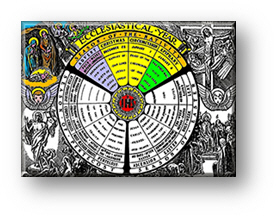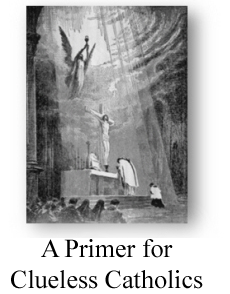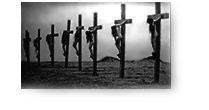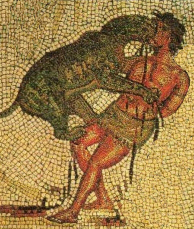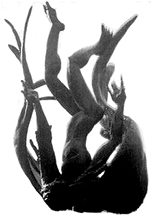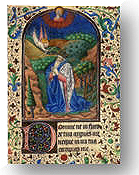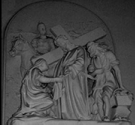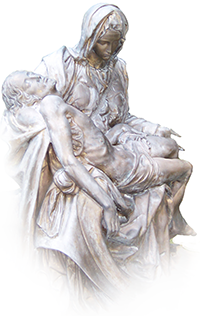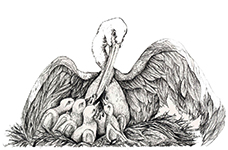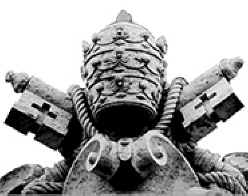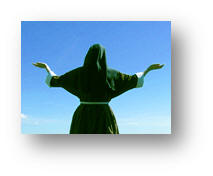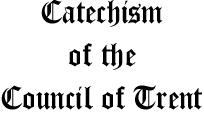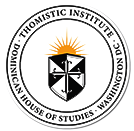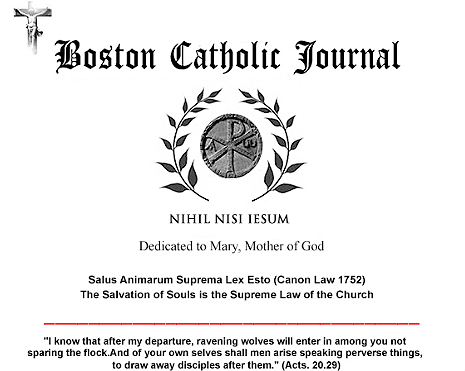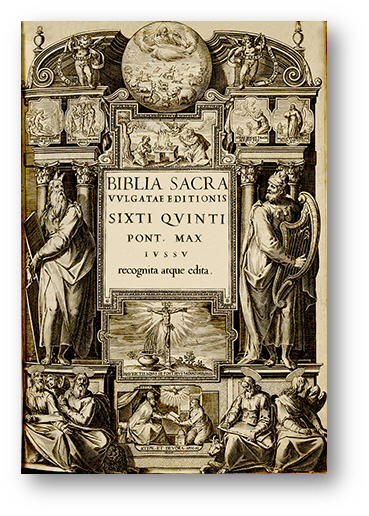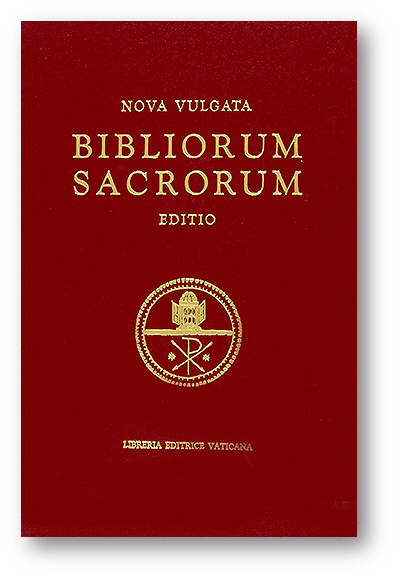|
Post-Vatican II Corruption of Sacred Scripture:
Hermeneutics and a Spurious New Catholic Bible
|
|
The The Sixto-Clementine Vulgate
Bible |
The “Nova Vulgata” Bible of John Paul II |
You already know, of course, that Vatican II changed, cancelled, abolished, vilified, and wantonly discarded so much that is indispensable — that is to say, intrinsic to — understanding authentic Catholicism. It shred, not just the fabric, but the very identity of what it means to be a Catholic — one faithful to Christ. and to his Holy Bride the Church as it had been authentically lived for the 2000 years before the corruptions introduced by Vatican II.
But you knew that, right? Otherwise, you would not have landed here.
But did
you know that in addition
to the devastating changes made to the Most Holy Sacrifice of
the Mass; to the Sacraments, the Priesthood, Religious Life,
and Catholic Devotions (to name only a few) — that:
Vatican II
Also
Discarded the Traditional
Catholic Bible of 1,557 Years
changing
Holy Scripture
itself to accommodate Ecumenism!
I will wager that you did not know this (either!).
It did not accord with “modern man’s” sensibilities, or the morbid and unilateral pursuit of ecumenism (the pursuit of man instead of God): it was divisive, for it did not correspond with the myriad Protestant translations of the Bible first subjected to that spurious literary device called “hermeneutics” invented by 18th century German Lutheran theologian Friedrich Schleiermacher (“Father of Modern Liberal Theology”) for whom “Religion is ... above all and essentially an intuition and a feeling”. Does that sound familiar?
Hermeneutics subsequently
falsified and corrupted Sacred Scripture, and has remained near
and dear to all Modernist Catholic pontiffs following Vatican
II. Indeed, we need only recall German Cardinal Ratzinger’s
(Benedict XVI’s) repeated insistence on “the hermeneutics
of continuity” — of which there is factually none.
Now 63 Alternate Interpretations?
Before Vatican II we had only one meticulously examined and authorized translation: Saint Jerome’s — 1,557 years old! Despite its unquestioned and unquestionable pedigree dating to the 4th century, how, it was asked, could it possibly compete with, or be reconciled to — or otherwise come to terms with — the “Post-Catholic Conciliar church’s” “ecumenically-the-same-but-separated-brothers’” hermeneutic scholarship which resulted in 63 alternate (and conflicting) versions in English alone?!
After all, who is to say that only the traditional Catholic translation is the correct one? Indeed, Holy Mother Church had only 16 centuries — one thousand, six-hundred years — of authentic Catholic scholarship and commentaries accompanying the sacred text — to say nothing of the endorsement of all the popes, saints, martyrs, and scholars of 2000 years? Such arrogance! Such a lack of ecumenical sensitivity!
Perhaps we have been reading the Bible in Latin (from the Greek) too much — and according to Saint Jerome’s unequaled translation — to have missed this monumental effrontery — this brazen submission to Modernism as the sine qua non of ecumenism.
The Rational Enlightenment led Protestant exegetes to view Scriptural texts as secular historical texts, interpreting Scripture in light of prevailing political and social events in an effort to reconcile apparent contradictions in Biblical texts by understanding them through contemporary issues. Such exercises in “hermeneutics” were as little adept at contriving Holy Scripture to the secular ends of man then as they are today.
This sounds strangely familiar, yes? It should. It accords with the Vatican II mantra of Ecumenism — which, perforce, entails “hermeneutics,” so dear to Martin Luther (the acknowledged hero of Francis), John Calvin, Ulrich Zwingli, and the anti-Catholic “Rational Enlightenment” mentality of (godless) materialists who, in France’s Reign of Terror alone took more than 16,000 lives — to prove that they were both rational and enlightened.
The Sixto-Clementine Vulgate
Bible — or the Douay Rheims Catholic Bible — went
into the same Modernist trash pile where nuns’ habits and veils,
and where priests’ collars were burned together with the
Baltimore Catechism (since Catechesis became non-existent
following Vatican II — being potentially divisive and an impediment
to Ecumenism), together with rings of perpetual vows — where
everything holy was tossed as into a valley called Gehenna,
where the smoke ever rises and the fumes are fraught with
insolence.
Didn’t they burn books in Nazi Germany, too?
Why does so much feculence historically flow out of Germany? Especially the nominally Catholic German Church with its vast wealth and its far greater ecumenical correspondent, Lutheranism? This is especially true since Francis’s draconian insistence on localized synodality which abolishes the notion of ecclesial unity! (the famous and oft-cited verse, “ut omnes unum sint” — “that they may be one” (Saint John 17.21) — is not to be confused with John Paul II’s eponymous encyclical, “Ut unum sint,” the very first papal encyclical devoted exclusively to Ecumenism — not as the heresy that it is, but to promote the heresy of Ecumenism!
We need only appeal to the spectacle of the “Inter-Faith Summit” called by John Paul II at Assisi in 1986 — when,
| “a bishop of Rome [the pope] would gather together pagan votaries and invite them to perform their idolatrous rites, confounding them with his own” 2 |
A summit that culminated in sacrilege on October 27, 1986, when,
| “with due permission of John Paul II, the Dalai Lama and Tibetan Buddhist monks of his sect placed a small statue of Buddha over the tabernacle of St. Peter Church in Assisi. The statue was encased in a glass cylinder, Two pagan religious books were placed on either side of the tabernacle along with candles that burned in honor of the idol.” 3 |
“Saint” John Paul ...
the Great? I think not. Simply another post-Conciliar papal
iteration of Ecumenism staining the Seat of Peter.
It troubles me that the truth troubles you ...
There are far too many ideologues and far too few saints in that imposture known as the “Post-Conciliar Church of Vatican II” or “The Church of the New Advent.”
Catholicism is not an epithet
— as it was to Luther and is to Francis. It
is the sole means to salvation, for it alone is the Bride and
the Body of Christ. It is the incarnation of holiness on earth.
There is nothing holy that is not Catholic — and nothing
Catholic that is not holy.
Trick Question: “Love God and sin boldly.”
Who said this? Francis or Luther?
PS: do not be confused simply because Francis placed a statue of Luther in the Vatican ...!
Geoffrey
K. Mondello
Editor
Boston Catholic Journal
_________________________
1 https://en.wikipedia.org/wiki/Hermeneutics
2 https://www.traditioninaction.org/RevolutionPhotos/A169rcBuddhaAssisi.htm
3
https://onepeterfive.com/remembering-the-sacrilege-of-assisi-i-thirty-years-later/
Comments? Write us:
editor@boston-catholic-journal.com
|
Totally
Faithful to the Sacred Deposit of Faith entrusted
to the Holy See in Rome
“Scio
opera tua ... quia modicum habes virtutem, et servasti verbum
Meum, nec non negasti Nomen Meum”
Copyright © 2004 - 2025 Boston
Catholic Journal. All rights reserved. Unless otherwise
stated, permission is granted by the Boston Catholic Journal
for the copying and distribution of the articles and audio
files under the following conditions: No additions,
deletions, or changes are to be made to the text or audio
files in any way, and the copies may not be sold for a profit.
In the reproduction, in any format of any image, graphic,
text, or audio file, attribution must be given to the Boston
Catholic Journal. |

